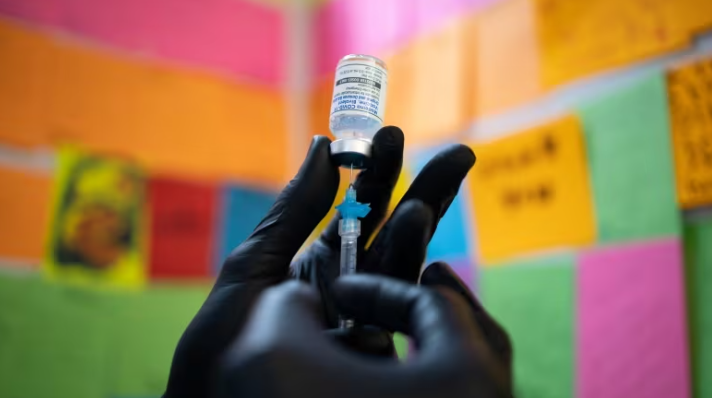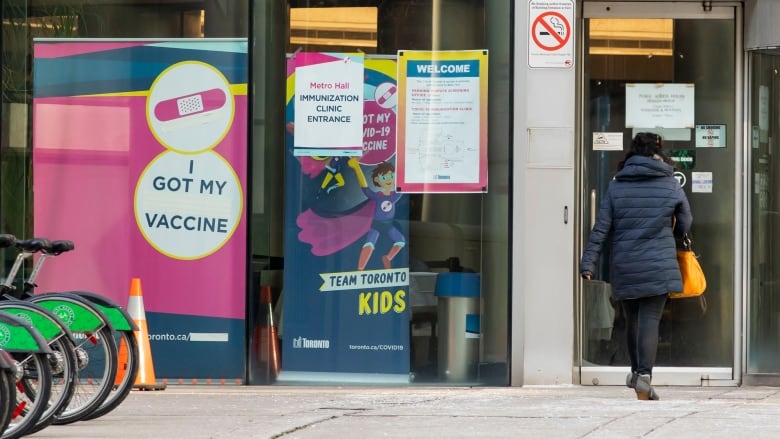Early signs suggest fall COVID-19 wave starting in Canada — before updated boosters are available

Positive tests, hospitalizations creeping up as drugmakers seek new vaccine approvals
There are early signals Canada is already entering a fall COVID-19 wave, while updated booster shots likely remain weeks away.
Earlier this week, the Public Health Agency of Canada said fluctuations in virus activity across the country could be an “early sign” of increased infections.
The percentage of COVID tests coming back positive, for example, had been gradually declining since the spring, but started going up again over the last month — most recently hitting nearly nine per cent. Hospitalizations increased in August as well, jumping roughly 11 per cent in a week, as the number of hospital beds occupied by COVID patients hit more than 1,700 by Aug. 15.
Cross-Canada wastewater signals are also rising. By late July, at least seven of the 39 sites tracked by federal officials had reported an increase, and that number has nearly doubled since then to at least 13.
Western University microbiologist Eric Arts said Ontario’s wastewater in particular is showing an increase in virus samples, but with reduced reporting and limited testing across much of the country, the full picture is hazy. What is clear, Arts added, is that caseloads in the U.S. are already going up “dramatically,” meaning Canada’s wave may not be far behind.
“Everyone’s hearing, myself included, anecdotal evidence of new infections of people that we know,” he said.
Waning immunity, new subvariant may play role
How big Canada’s fall surge becomes will largely hinge on the country’s level of population immunity, experts say, as well as the timing of fall booster shots that aren’t yet approved in either Canada or the U.S.
“We’re having up-and-down wobbling of our COVID numbers as we balance out transmission with immunity,” said researcher and epidemiologist Caroline Colijn, a Canada 150 Research Chair in Mathematics for Evolution, Infection and Public Health at Simon Fraser University.
As CBC News recently reported, research shows a majority of the population has developed some level of immunity against SARS-CoV-2, thanks to high rates of vaccination and three-quarters of Canadians likely having detectable antibodies linked to prior infections. Hybrid immunity — developed through a combination of both prior vaccination and infection — is thought to be a particularly robust form of protection.
But while many individuals’ immune systems are now better trained to recognize this threat, reducing rates of serious illness and death over the course of the pandemic, the level of protection needed to avoid another infection in the first place can fade over time.
“We haven’t had a large COVID wave in the summer, and we haven’t had a lot of vaccinations. So that protection against infection might have waned to some extent,” said Colijn. “And that puts us in a position for potentially a larger wave.”
A contagious subvariant called EG.5 that’s circulating widely right now could also help fuel a surge, though scientists are still assessing the risks posed by the Omicron offshoot.
Early evidence suggests it’s no more severe, yet it does appear better able to evade front-line immune defences, allowing it to infect — and re-infect — more people.
There’s no cause for panic, Colijn stressed. But among people that may not have an infection or booster shot in months, a fast-spreading subvariant can find plenty of new hosts.
“You don’t need a lot more severity to cause a large problem if you have a lot more numbers,” she warned.

‘Our system is fragile’
The challenges stemming from another wave would hit Canada on multiple fronts, said infectious diseases specialist Dr. Donald Vinh, an associate professor in McGill University’s department of medicine.
For one thing, more COVID infections would increase pressure on the health-care system through higher demand on hospitals, coupled with higher rates of health-care workers being sick, Vinh said.
“That combination can become problematic. We know that our system is fragile,” he said. “And we’ve dealt with this fragility from a surge in COVID cases in the community before … but there’s only so many of those that the health-care system can take.”
In terms of the direct impact on patients, Vinh said that while high levels of hybrid immunity should prevent many life-threatening illnesses, there is also the potential for lasting health impacts from first or repeat infections, including long COVID.
Booster shots could shore up Canadians’ immunity this fall, particularly as drug makers have adapted their vaccines to better match currently circulating strains, but Vinh cautioned the “cycles are not in sync.”
The U.S., which typically approves new vaccines faster than Canada, hasn’t yet signed off on new formulations, and close watchers aren’t expecting those approvals until the end of August, with distribution sometime after that.
“The timing is not great,” Vinh said. “Because if we anticipate that the U.S. will have their rollout somewhere around the end of September, or maybe early October, realistically, in Canada, we’re probably looking at maybe mid to late-October, or God forbid, even a little bit later.”
Experts recommend boosters, basic precautions
Canada’s national vaccine advisors have already recommended getting an updated dose once fresh vaccines do arrive, particularly if you’re at a higher risk for severe illness, including seniors aged 65 and up, people living in long-term care homes, pregnant individuals, and anyone with underlying medical conditions.
Those national guidelines also suggest waiting roughly six months after a previous vaccine dose or a known SARS-CoV-2 infection, as research suggests the shots are more effective when they’re spaced out from an active infection or prior vaccination, as CBC News has previously reported.
While the shots offer lasting protection against severe disease, Arts said there’s a downside to waiting too long between doses: “We know the longer that we go out without a booster, the more likely we potentially, if exposed, will get infected.”
Upcoming shots could help blunt the end of a COVID wave, he added, “but it’s not going to prevent this wave now.”
Vinh said Canadians can also bring back basic precautions in the months ahead, such as avoiding crowded indoor locations, wearing a mask, and staying away from others when sick, while businesses can consider boosting indoor ventilation as much as possible.
Even at this point, however, Colijn stressed we’re in a better place than the U.S. heading into the fall, given the higher levels of vaccine uptake in Canada over the last few years — so a spike in cases mirroring the surge south of the border isn’t inevitable.
“Whether it turns into a big wave or not,” she said, “we’ll have to see.”
Related News
Carney warns of ‘tough days ahead’ as tariffs make U.S. recession ‘likely’
Donald Trump’s latest round of tariffs is only a few days old, but the havocRead more
Top American scientists just lost their jobs. Canada is rolling out the welcome mat
Many top scientists in the U.S. are now out of a job. Health Secretary RobertRead more
